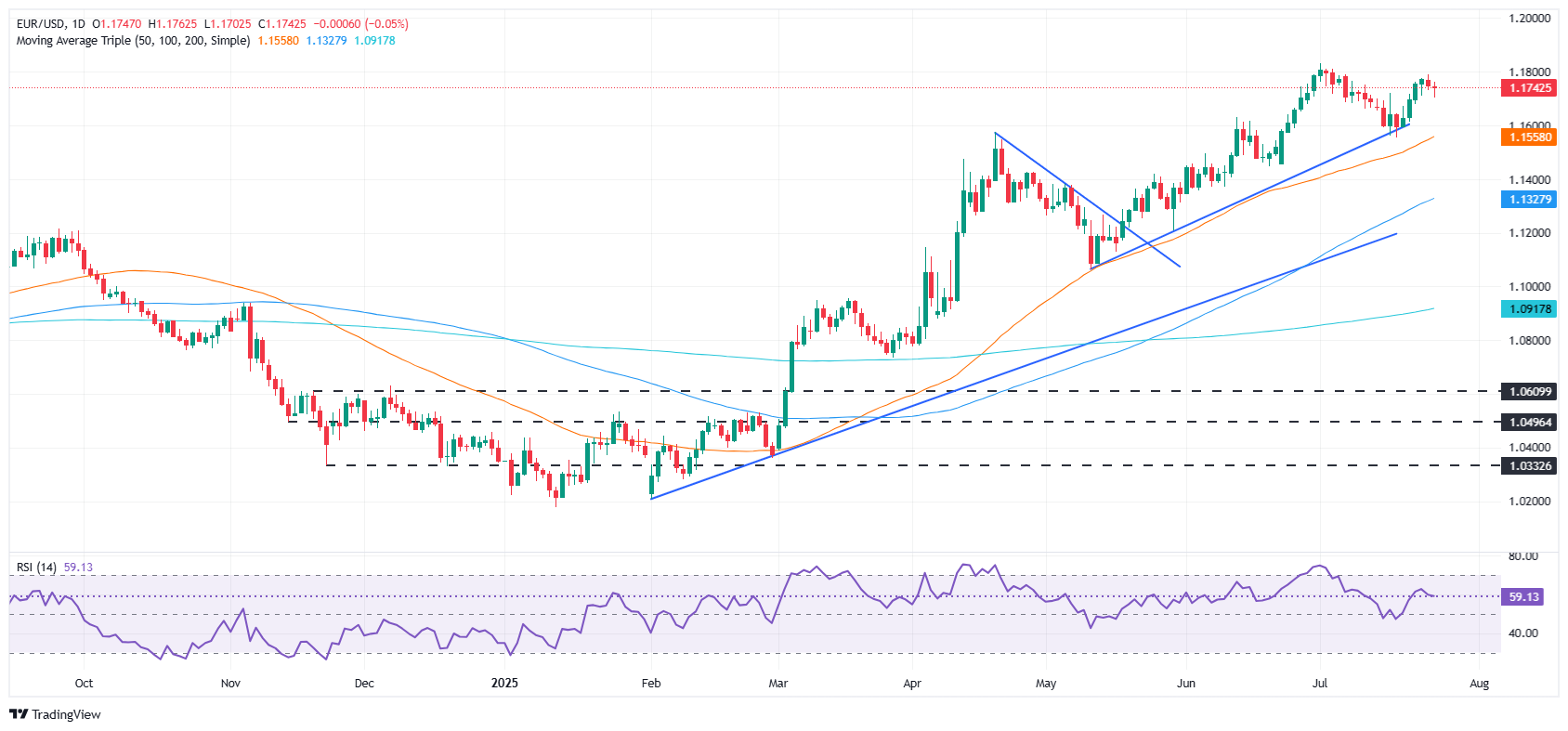
- EUR/USD sees uplift from potential US-EU agreement as deadline approaches.
- US economic data mixed with weak Durable Goods Orders but strong jobless claims, influencing Federal Reserve rate expectations.
- European Central Bank maintains stable rates, with eyes on upcoming Federal Reserve meeting for further cues.
The EUR/USD pair concluded the week with a nearly 1% increase on Friday, though it closed the day unchanged after mixed economic signals from the United States were counterbalanced by optimistic trade developments. The pair is currently trading at 1.1741.
Market sentiment remains positive as recent trade updates suggest a nearing US and EU agreement. US economic reports indicated a decline in Durable Goods Orders, which was unexpected following significant gains in May, as reported by the US Department of Commerce. However, robust jobless claims data, despite a downturn in manufacturing activity as per the S&P Global Manufacturing PMI, led investors to anticipate a less dovish stance from the Federal Reserve in the upcoming meeting.
In Europe, the European Central Bank held interest rates steady, opting for a cautious approach amid varying opinions within the Governing Council. The economic calendar for the next week is full, though no major updates were scheduled for this Friday.
EU – US Trade Developments
US President Donald Trump mentioned nearing a deal with China and indicated a possible agreement with the EU, though he noted that the EU might need to reduce its tariffs.
Earlier in the week, reports of a US-Japan agreement boosted the EUR/USD. Further support came after the Financial Times reported that the EU and the US are likely to sign an agreement before the August 1 deadline, according to sources close to the matter.
FOMC Meeting in Focus Next Week
The upcoming week in the US includes the Federal Open Market Committee (FOMC) meeting scheduled for July 29 – 30. The Fed is widely expected to maintain interest rates within the 4.25%-4.50% range, with a 98% probability.
Market Movers: EUR/USD Post-ECB Decision and US Economic Data
- US Durable Goods Orders for June saw a significant drop of 9.6% MoM, a sharp reversal from May’s 16.5% increase, primarily due to a decrease in aircraft demand. Despite this, the data was slightly better than the expected -10.8% contraction, with transportation equipment orders falling by 22.4%. Excluding transportation, Core Durable Goods Orders edged up by 0.2%, indicating continued underlying business investment strength.
- The latest Initial Jobless Claims in the US were better than expected, suggesting ongoing labor market resilience, even as manufacturing activity contracted according to S&P Global.
- In trade news, President Trump announced that most trade agreements are finalized, with upcoming communications to detail tariffs between 10% and 15%. However, he rated the chance of an EU agreement at about 50%.
- Despite ongoing negotiations, EU member states are poised to vote on imposing EUR 93 billion in counter-tariffs on US goods if no trade agreement is reached and the US imposes a 30% tariff.
- The ECB maintained a 2% interest rate, aligning with expectations and highlighting that recent data matches previous assessments, though future decisions will be made on a meeting-by-meeting basis due to prevailing uncertainties.
- The US economic calendar next week will include the Fed’s decision, preliminary Q2 GDP figures, Core PCE data, and Nonfarm Payroll statistics.
- In the EU, the economic schedule includes Retail Sales data from Germany and Spain, along with inflation figures from Spain, Germany, and the broader EU. Market participants are also anticipating GDP data releases for the EU and Germany.
Technical Outlook: EUR/USD Stability Around 1.1750
EUR/USD is stabilizing after reaching a weekly peak of 1.1788, just below the critical 1.1800 threshold. Although the Relative Strength Index (RSI) suggests bullish momentum, it is approaching the neutral zone, indicating potential momentum loss.
A dip below the 20-day Simple Moving Average (SMA) at 1.1714 could lead to a retest of the 1.1700 support level. Further declines could target the 50-day SMA at 1.1556. Conversely, a sustained move above 1.1800 could bring the year-to-date high of 1.1829 into play, with the next resistance level at 1.1850.












Leave a Comment